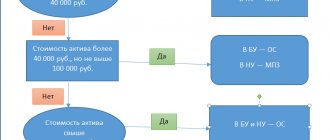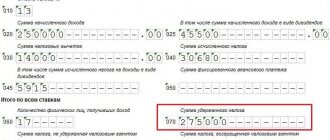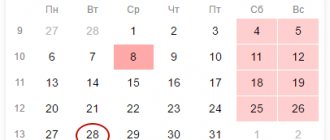How does it affect transport tax?
All owners of cars (except for preferential categories and certain cases) and other vehicles annually pay transport tax, calculated as follows:
Transport tax = Tax base (engine power in hp) * Tax rate * Increasing factor * Number of months of use / 12
For each car, the tax value is calculated individually. The tax base is calculated based on engine power, but the tax rate can vary from region to region (federal values can be increased up to 10, and sometimes more times).
One of the important factors determining the amount of transport tax is the increasing coefficient. It was introduced not so long ago - in 2014. The final amount of tax paid due to the increasing coefficient can increase significantly - from 1.1 to 3 times.
For example, if the tax amount for the year was 10,000 rubles, then if the luxury tax is paid, its amount can increase to 11,000 - 30,000 rubles.
Average cost of a vehicle
List of passenger cars with an average price of 3 million rubles. according to paragraph 2 of Art. 362 of the Code must be posted annually on the official website of the Ministry of Industry and Trade no later than March 1. In pursuance of this norm, on February 28, 2014, a corresponding List appeared on the website of the specified ministry. In total, it contains 191 models of passenger cars from such brands as Aston Martin, Audi, Bentley, BMW, Bugatti, Cadillac, Ferrari, Hyundai, Infiniti, Jaguar, Jeep, Lamborghini, Land Rover, Lexus, Maserati, Mercedes-Benz, Nissan, Porsche, Rolls-Royce, Toyota and Volkswagen. The Ministry of Industry and Trade notes that when forming this List, statistical data, customs statistics and information on transactions with relevant models were taken into account.
The procedure for calculating the average cost of passenger cars is also determined by the Ministry of Industry and Trade. The corresponding Department Order No. 316 dated February 28, 2014 was registered with the Ministry of Justice on April 2, 2014 (the document comes into force on April 20, 2014). It contains two formulas.
The first formula is applied in cases where the manufacturer or his authorized person is represented in the Russian Federation. This formula looks like this:
Spr = (P1 + P2) / 2
Where:
Spr - average cost of a car;
P1 - the recommended retail price of a car of this make, model, basic version of the car and year of manufacture, obtained as of July 1 of the corresponding tax period;
P2 - the recommended retail price of a car of this make, model, basic version of the car and year of manufacture, obtained as of December 1 of the corresponding tax period.
In this case, the Ministry of Industry and Trade will request indicators P1 and P2 from automakers or their authorized persons.
The second formula is somewhat more complicated. It applies if the car manufacturer or its authorized person is not represented on the territory of the Russian Federation or when information on the recommended retail price of the vehicle has not been received by the Ministry of Industry and Trade. It also determines the average cost of a car that has been manufactured for more than 5 years. This formula looks like this:
Where:
Ck is the average cost of a car;
Pcr max - the maximum sales price of a car in the Russian Federation of this make, model, basic version of the car and year of manufacture as of December 31 of the corresponding tax period according to catalogues;
Pcr min - the minimum sales price of a car in the Russian Federation of this make, model, basic version of the car and year of manufacture as of December 31 of the corresponding tax period according to catalogues;
Kt is a coefficient equal to the amount of the recycling fee and import customs duty paid for a similar car;
Kc is the coefficient for converting the catalog price of a car into prices in ruble equivalent according to the exchange rate of the year of manufacture of the car. This, in turn, is determined by the formula:
Where:
Q1 is the foreign exchange rate to the currency of the Russian Federation, established by the Bank of Russia as of January 1 of the year of manufacture of the car;
Q2 is the foreign exchange rate to the currency of the Russian Federation, established by the Bank of Russia as of December 31 of the year of manufacture of the car.
Well, if data on car prices is taken from Russian catalogs, then calculations are made with coefficients Kc = 1 and Kt = 0.
On the one hand, of course, if the purchase price of the car were used in the calculations, it would be much simpler. On the other hand, it is understandable why legislators took a different path. Indeed, in order to reduce the tax burden, it seems that in vehicle purchase and sale agreements, the parties would, by agreement, indicate minimum prices.
Which cars do you have to pay more for?
The increasing coefficient began to be applied for the first time in 2014 after the corresponding additions were made to Art. 362 of the Tax Code of the Russian Federation (with the entry into force of Federal Law No. 214-FZ of July 23, 2013).
Luxury car tax payers should remember that they do not have to pay it separately. Moreover, it is impossible to calculate it without reference to the transport tax. It will be easier for individuals than for business representatives, because they will not have to calculate the amount of deductions themselves - all information will be indicated in the notification of the need for payment.
However, sometimes people still want to know whether the vehicle tax increase applies to their cars. It is important to understand that it is used exclusively for passenger cars. That is, if a person purchased an expensive truck or bus, then he will not have to pay for the “luxury”.
Any car included in the “luxury” list must simultaneously satisfy a number of the following criteria:
- passenger car;
- price – not less than 3 million rubles;
- The car is on the list of the Ministry of Industry and Trade.
Every year, the Ministry of Industry and Trade publishes a list of luxury cars on its website. So, to calculate the tax in 2020, you need to use the 2020 list, because before December 1 you need to pay the tax for the previous reporting period. The information in the list is divided into several groups depending on cost. When calculating the tax paid in 2020 (for 2020), 909 car models may be subject to the increasing coefficient. If a car is not included in this list, then it will not be classified as luxury, regardless of the cost. In general, the list of the Ministry of Industry and Trade has the following groups of cars:
- Priced from 3 to 5 million rubles. There are 424 of these on the 2020 list. Expensive cars in this class include models from brands such as Audi, BMW, Infiniti, Jaguar, Land Rover and others.
- Priced from 5 to 10 million rubles. There are 320 of them when calculating the tax for 2017. There are cars from Aston Martin, Audi, BMW, Bentley, Lexus, Maserati, etc.
- With a price of 10 to 15 million rubles. There are only 95 such models for 2017. They include brands like Aston Martin, Bentley, Ferrari, Lamborghini, Porsche.
- Priced at more than 15 million rubles. There are 70 of them. There are models from such famous brands as Bugatti, Ferrari, Lamborghini, Rolls-Royce.
The information in the list is presented in tabular form and contains information about the make and model of the car, the type and size of the engine, as well as the period from the date of manufacture during which the luxury tax is paid.
The presence of a car on the list of the Ministry of Industry and Trade does not mean that you will necessarily have to pay tax on it. It is necessary to pay attention to the last column, which indicates the maximum (sometimes minimum) number of years that have passed since the date of issue at which the increasing factor must be used.
Example . Starovoitov purchased a 2012 Rolls-Royce Phantom Coupe from Yusupov in 2020. After the purchase, he became interested in whether he would have to pay luxury tax for the previous period in 2020?
This car model is actually on the 2020 list of the Ministry of Industry and Trade. However, taking into account the date of manufacture (when calculating the increasing coefficient, both the year of manufacture and the year for which the tax is paid are taken into account - when calculating the tax rate, the year of manufacture, on the contrary, is not taken into account), the car is already more than 4 years old. Consequently, Starovoitov will not have to pay luxury tax.
Calculation of transport tax on expensive cars
The issue of introducing a luxury tax has been raised since 2003. The State Duma has more than once received bills providing for the introduction of a differentiated personal income tax rate in order to reduce the level of social inequality, but none of them found support from parliamentarians. And in 2012, President Vladimir Putin, addressing his annual message to the Federal Assembly of the Russian Federation, stated that it was impossible to abandon the “flat” personal income tax scale, since progressive taxation of citizens would not ensure social justice. In his opinion, the introduction of progressive taxation will be a burden for millions of people with average incomes. “If you start counting where this will lead, you will see that it will happen. There will be tax evasion and the budget and treasury will receive corresponding amounts of money from this tax. This means that we will have deficits in financing the army, pensions, and the budgetary sector. Therefore, we need to act extremely carefully in this area,” Putin said then. At the same time, he advocated the introduction of a “luxury tax” in the country, emphasizing that the Government of the Russian Federation needs to implement the fundamental decisions taken on the “luxury tax” in the first half of 2013, including luxury real estate and expensive cars.
Initially, it was assumed that luxury real estate and expensive cars would be subject to the luxury tax. However, in the end, it was decided to levy an increased tax so far only on owners of vehicles whose value exceeds 3 million rubles. The corresponding Law of July 23, 2013 N 214-FZ came into force on January 1, 2014.
Size of the multiplying factor
In order to correctly calculate the amount of tax (for legal entities) or to check the accuracy of the information in the notification (for individuals), you need to know the size of the increasing coefficient.
For 2020
For 2020, transport tax is paid by individuals and legal entities in 2020. In this case, when calculating, you need to use the old values:
| Price | Number of years since graduation | Applicable coefficient |
| 3 – 5 million rubles | Less than 1 | 1,1 |
| 1 – 2 | 1,3 | |
| 2 – 3 | 1,5 | |
| 5 – 10 million rubles | Up to 5 | 2 |
| 10 – 15 million rubles | To 10 | 3 |
| Over 15 million rubles | Up to 20 | 3 |
Moreover, you additionally need to look at the age requirements in the list of the Ministry of Industry and Trade, since different car models have their own values.
Example . Evgrafov owns a 2020 Audi R8 quattro. For 2020 he will pay transport tax. What magnification factor should he use? This car is included in the list of cars worth from 5 to 10 million rubles. Moreover, the corresponding coefficient is applicable to cars under 3 years old. In this case, you will have to pay luxury tax using coefficient 2.
From 2020
Since 2020, the calculation of the increasing coefficient has changed slightly after the entry into force of Federal Law No. 335-FZ of November 27, 2017. From January 1 of this year (according to the new rules, payments for 2020 will be made in 2020), the coefficients for cars with a price of 3 to 5 million rubles have changed. Now the three subgroups are combined into one - up to 3 years. A single coefficient is established for them - 1.1. In general, the table of increasing coefficients looks like this:
| Price | Car age | Coefficient |
| 3 – 5 million rubles | Up to 3 years | 1,1 |
| 5 – 10 million rubles | Up to 5 years | 2 |
| 10 – 15 million rubles | Up to 10 years | 3 |
| From 15 million rubles | Up to 20 years | 3 |
This means that the amount of tax, taking into account the increasing coefficient, for owners of new cars in the price category from 3 to 5 million rubles will decrease.
Transport tax taking into account the increase factor
When calculating the transport tax taking into account the increase factor, several specific operations should be performed, namely:
- calculate the tax in accordance with the legislation of the Russian Federation and the calculation formula used
- decide which group of vehicles the car belongs to and whether it is even included in the list of the Ministry of Industry and Trade
- multiply the previously calculated transport tax by an increased coefficient corresponding to the selected group
Note that when determining the group, it is necessary to pay special attention to the number of years that have passed since the date of release of the vehicle, since if it does not correspond to this indicator, the increase factor should not be applied. The calculation of this period begins with the year the car was launched from the assembly line and ends with the year for which the transport tax is calculated. More information about this can be found in the Letter of the Federal Tax Service of Russia dated 03/02/2015 No. BS-4-11/ [email protected]
The calculation of the transport tax, taking into account the increased coefficient, should be carried out independently by those legal entities that are payers of this tax. At the same time, they must calculate not only the transport tax as of the calendar year, but also advance transfers for it. In addition, they must report to the tax authorities for the calculations made, and in case of an error they may receive an administrative penalty.
As for individuals, they do not need to independently calculate the transport tax, taking into account the increasing coefficient, since this operation is carried out by the tax authorities. But it is still necessary to understand this issue so that you can control the correctness of the calculation of transport tax, since this money will need to be paid from your budget. If there is an error or unclear calculation, you can contact the tax office hotline with a request to explain any particularly difficult points.
It must be said that changes are periodically made to the legislation on taxes, including transport payments, which must be monitored. Thus, the latest changes affected not only the list of cars compiled by the Ministry of Industry and Trade, but also increasing coefficients, the list of which was adjusted in 2018 and instead of 5 there are only 3 positions.
Is it possible not to pay luxury tax?
The increasing coefficient itself does not provide for any preferential categories. The only thing that can get rid of its use is exemption from transport tax in principle. For example, these categories include the following types of vehicles:
- cars with special devices for transporting disabled people;
- cars with power up to 100 hp. pp., at the disposal of social protection authorities;
- stolen cars;
- cars that are the property of federal government bodies or executive authorities.
If the car is not included in any categories, then you will have to pay transport tax, and if the previously stated conditions are met, an increasing coefficient will be applied to it.
Tax calculation: from total...
It is quite obvious that the average cost of a car for the purpose of applying coefficients for expensive cars according to the “methodology” approved by the Ministry of Industry and Trade will be determined no earlier than December of the current tax period. It turns out that only then will organizations be able to accurately determine which increasing coefficient should be used when calculating transport tax. Then the question arises: how then to calculate advance payments for transport tax?
Let us remind you that transport tax is regional. It is established by the laws of the constituent entities of the Russian Federation and is required to be paid on the territory of the corresponding constituent entity of the Russian Federation (Article 356 of the Tax Code). Subjects of the Russian Federation determine the tax rate within the limits established by the Code, the procedure and terms for its payment.
The objects of transport tax are vehicles registered in accordance with the established procedure in accordance with the legislation of the Russian Federation (Article 358 of the Tax Code). The tax period for transport tax in accordance with Art. 360 of the Code recognizes the calendar year. The reporting periods for taxpayer organizations are the 1st, 2nd and 3rd quarters. At the same time, regional authorities are given the right not to establish reporting periods.
The amount of tax payable to the budget at the end of the tax period is calculated by multiplying the tax base by the corresponding tax rate (clause 2 of Article 362 of the Tax Code). Moreover, if the constituent entities of the Russian Federation have not canceled the reporting periods for this tax, then at the end of the year you need to pay the difference between the calculated tax amount and the amounts of advance payments to be transferred at the end of the reporting periods. In turn, advances amount to 1/4 of the product of the corresponding tax base and the tax rate (clause 2.1 of Article 362 of the Tax Code).
General calculation procedure
To calculate the tax taking into account the increasing coefficient, the car owner must:
- Make sure that his car is on the list of the Ministry of Industry and Trade and is within the declared age.
- View the power of your engine. It will be the tax base. You need to use values in l. s., not kW. If the power is written in kW, it must first be converted to hp. With.
- Find out the tax rate in your region. They are usually specified in regional legislative acts. Additionally, the power and age of the car may be taken into account.
- Select the appropriate multiplying factor.
- Multiply the resulting values. If the car was purchased during the reporting period, then you will additionally need to multiply the resulting value by the number of months of ownership divided by 12 months.
This will complete the tax calculation. Individuals calculate the value themselves to verify accuracy, since the amount payable is sent to them in the notification.
Formula for calculation
The formula for calculating vehicle tax taking into account the increased coefficient will be as follows:
Transport tax = TPnach * Kp,
where TPnach is a transport tax, initially calculated according to the basic rules enshrined in the Tax Code of the Russian Federation. The payment in this case is equal to the product of the tax base by the tax rate and the car ownership coefficient;
Kp is a multiplying factor depending on the characteristics of the vehicle.
For a clearer understanding, let’s present the formula with the TPinch indicator in expanded form:
Transport tax = Rate * Tax base * * Kp
Let's look at a specific example of calculating transport tax with an increasing coefficient:
Legal Consult LLC has owned an Audi Q7 quattro car with a 2995 cm3 gasoline engine for six months. Its cost is 3 million rubles. The previously calculated transport tax was 9,675 rubles.
The transport tax, taking into account the increasing coefficient, in 2020 will be equal to:
Transport tax = 9,675 * 1.5 = 14,512.50 rubles.
Transport tax, taking into account the increase factor in 2020, will be equal to:
Transport tax = 9,675 * 1.1 = 10,642.50 rubles.
The formula for calculating transport tax is the same for each subject of the Russian Federation, but the result obtained will depend on what the tax rate is in a particular region and what increasing factor is applied to the vehicle. At the same time, we note that this formula is also used for different transport owners (legal entities and individuals), and the first of them use it independently, and the second can use it to check the correctness of payment calculations by tax officials.
Note that if a legal entity used a formula for calculation without a multiplying factor, the tax inspectorate, if an error is discovered, will not only force you to pay the missing amount of tax, but will also impose an administrative penalty. It represents a fine of 20% of the amount that the business entity underpaid. In addition, a penalty will also be charged, since there was a delay in payment.
Also, the transport tax must be calculated and paid until it is deregistered with the relevant government agencies, even if it is not used for technical or other reasons.
Transport tax rate in Russian regions
Rates and benefits for a registered vehicle are established by law . But regional authorities have the right to increase or decrease these indicators.
The tax rate on a vehicle directly depends on legislative acts approved by regional authorities.
The transport tax coefficient by region is given on the Federal Tax Service website in the section “reference information on property taxes”.
To determine it, you need to find your region in the table and go to its page. Then select the following:
- transport tax;
- select a region - in the line that will appear there will be a complete list of regions of Russia;
- determine the reporting period - year;
- municipality, but this is not mandatory;
- click the “find” button.
To obtain detailed information about tax rates and benefits in 2020, you need to click on the “more details” link in the right column of the list.
As a result of the search, the system will identify a document that needs to be relied upon when calculating the tax rate for the subjects of a certain region.
The rates taken to determine the transport tax are not divided into rates for legal entities and individuals. Their criteria depend on the power of the car and its type.
The Federal Tax Service website contains tables and information on transport tax rates by region in 2020 . The highest tax rates are in the central part of Russia.
In addition, their size is influenced by the production area of the region. Low rates for passenger cars were recorded in the Magadan region, Ingushetia, and the Chechen Republic.
In some regions, in order to support low-income families, rates are on cars with a capacity of up to 100 hp. With. broken down into smaller indicators.
The Law “On Transport Tax” is adopted in each region; it regulates the size of rates in the region and the frequency of payment for individuals and enterprises.
Deadlines for payment of transport tax
We have already noted above that there is no tax on luxury cars. The Tax Code of the Russian Federation establishes a standard transport tax, which in relation to luxury cars can be increased by applying a special coefficient.
Accordingly, the deadlines for paying transport tax are the same for all car owners.
Individuals are required to pay the TN by December 1 of each year for the previous year of ownership. That is, the tax, say, for 2020 will need to be paid before December 1, 2021.
There is no need to worry about deadlines, since no later than September a notification will be received from the tax office, in which:
- the exact amount of transport tax payable will be indicated;
- A receipt for payment will be included.
Legal entities pay transport taxes within the deadlines established at the regional level.
...to expensive cars
In the event that regional authorities, when introducing a transport tax, exercised their right and did not establish reporting periods for this tax, the increasing coefficient without any options is applied once - when calculating the tax for the year. By that time, all data, including the average cost of the vehicle, should already be known. After all, according to paragraph 1 of Art. 363 of the Code, the deadline for payment of transport tax cannot be earlier than February 1 following the reporting year.
The question may arise when calculating advance payments for transport tax, if the law of a constituent entity of the Russian Federation still establishes tax reporting periods. However, as follows from the Letter of the Federal Tax Service of Russia dated March 24, 2014 N BS-4-11/5316, there is no need to worry in this part either. Officials especially emphasized that the increasing coefficient must be applied to the tax amount when paying transport tax for the tax period.
We will demonstrate the procedure for calculating transport tax on expensive cars using examples.
Example 1. Let’s assume that an organization located in Moscow purchased and registered with the traffic police a Hyundai Equus 5.0 V8 GDI 2013 car for 2 million rubles. Engine power 430 hp. With. Moscow Law of July 9, 2008 No. 33 “On Transport Tax” sets the tax rate for a passenger car whose engine power exceeds 250 hp. s., is 150 rubles. for "horse". Tax reporting periods are not established. The Hyundai Equus 5.0 V8 GDI car is named in the List of cars worth over 3 million rubles, which is posted on the website of the Ministry of Industry and Trade. Accordingly, when calculating transport tax in relation to this vehicle, an increasing factor should be applied, regardless of the fact that it actually cost the company less than 3 million rubles. If we were talking about a regular vehicle with exactly the same characteristics, then transport tax would be payable in the amount of 64,500 rubles. (430 hp x 150 rub.). However, since we are dealing with an expensive car, we should use a multiplying factor. Let’s assume that according to the Ministry of Industry and Trade data received from automakers, the recommended retail price of the specified car as of July 1, 2014 will be 3.3 million rubles, as of December 1, 2014 - 3.5 million rubles. Then the average cost of our vehicle will be 3.4 million. Thus, the car falls into the cost category from 3 to 5 million rubles. and “age” - from 1 year to 2 years. Accordingly, an increasing factor of 1.3 is applied to this vehicle. This means that the tax payable will be 83,850 rubles. (RUB 64,500 x 1.3).
Example 2. Let’s assume that the car described in example 1 was purchased and registered by a company in a region where the law of a constituent entity of the Russian Federation establishes reporting periods for transport tax. For clarity, let's assume that the regional law for passenger cars with a capacity of 430 hp. With. The tax rate is also set at 150 rubles. for "horse". Then calculations with the budget should be made in the following order:
- At the end of the 1st, 2nd and 3rd quarters, it is necessary to pay advance payments for transport tax in the amount of 16,125 rubles. (RUB 64,500: 4).
- At the end of the year, we pay tax in the amount of 35,475 rubles. (RUB 83,850 - RUB 16,125 x 3).
On a note
When calculating transport tax in relation to expensive passenger cars, the provisions of paragraph 3 of Art. 362 Code. This provision allows you to adjust tax obligations if the vehicle was not registered for the organization for the entire tax period. In such situations, a special reduction coefficient is now applied, which is defined as the ratio of the number of full months during which the car is registered to the company to the number of calendar months in a year. In this case, the month of registration of the vehicle, as well as the month of deregistration of the vehicle, are taken as full months.
May 2014
Transport tax
Age of transport
In order to correctly calculate the transport tax, the number of years from the year of manufacture of the car is determined in calendar days as of January 1 of the current year.
It must be counted from January 1 of the year following the year of manufacture of the vehicle, and include the year for which the tax must be paid.
If at the beginning of the year for which the tax is calculated, the maximum number of years has expired, the increasing coefficient for this year is not applied.
Thus, there is a list of vehicles for which an increasing coefficient is set when calculating transport tax. CP directly depends on the cost and year of manufacture of the car.
This list of cars is posted no later than March 1 of each year on the website of the Ministry of Industry and Trade of Russia . When determining the transport tax, each list of cars is applied only for the year in which it was published.
Errors in using a multiplying factor when calculating taxes
Errors in calculations most often occur due to the incorrectly determined age of the vehicle. The number of years is calculated incorrectly and therefore people make mistakes about the service life indicated in that very list of the Ministry of Industry and Trade. For the same car model, the coefficient has different values depending on the service life.
It also happens that car owners do not find their expensive movable property that meets the criteria for additional taxation in the list of the Ministry of Industry and Trade and believe that they do not have to pay tax. This is not true, and you will have to pay extra tax with an increasing coefficient.
And the most common mistake for owners of expensive vehicles – legal entities – is the mistake of not paying advance payments taking into account the increasing coefficient. Art. 362 of the Tax Code of the Russian Federation clearly states the payment procedure.










